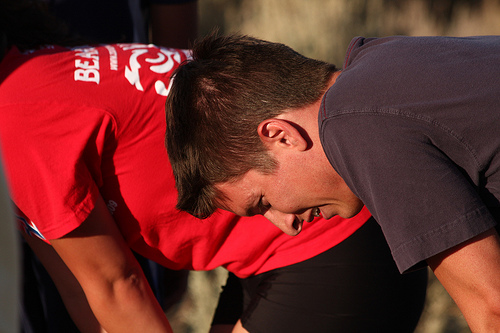By Kenneth Muir (Contributor) – Email
Print Edition: April 4, 2012
In sport there’s a taboo subject – nobody is talking about it, but everyone knows it’s out there. I’m talking about quitters. At least, that’s what they’re called behind their backs. Everyone else calls it burnout.
The problem is that athletes sometimes leave their sport feeling depressed, tired, and have an overall sore relationship with their sport. They often leave before they were able to do what they set out to accomplish. Goals are left on the drawing boards, so to speak. It can leave one with a bad taste in one’s mouth, for months or even years after the individual decides to quit the sport, and they may not fully understand why they feel the way they do; how things went so wrong so quickly. And the real shame? If they were just told in the first place about the consequences of burnout, many of them would still be in sport. Hopefully this article will serve to illuminate the issue, so that any athlete or potential athlete won’t suffer needlessly through a set of confusing and awful feelings if burnout ever arises.
Put simply, burnout is mental and/or physical exhaustion, a reduced interest in sport, and an overall decrease in sport performance. The symptoms range from depression to physiological signs of stress, such as increased anxiety, trouble sleeping and increased heart rate. There are four different ways to experience burnout:
Silva’s Training Stress Model
This model highlights those athletes who can’t seem to improve in their training. This is called staleness. To compensate, some athletes will try to over-train, or push their bodies beyond their limits, which can lead to injury. Essentially, burnout arises through training frustration. If the athlete can’t figure out how to get past the staleness in training, it may lead to burnout and ultimately a complete removal from sport.
Smith’s Cognitive-Affective Model of Stress
This pathway is a little complicated, but the gist of it is that the athlete becomes faced with a very stressful or overwhelming goal; one that the athlete doesn’t feel he/she will be able to accomplish. While this causes some athletes to feel even more motivated to succeed, it causes other athletes to experience anxiety, stress, depression, fatigue and eventually burnout. They become trapped by the monumental size of the problem they need to overcome, and the need to try to overcome it anyways, despite their internal pessimism. In contrast, the former athletes, who get motivated by massive challenges, are internally optimistic and won’t experience these problems.
The Investment Model
This applies to athletes who have been training and competing for some time. If they start to lose interest in sport, they’ll feel an inner conflict because of how much time they’ve already invested. Stepping back from competition would mean that all they’ve done so far in sport will have been for nothing. This problem becomes compounded if training is the only activity the athlete does in his/her spare time. The athlete will continue to train even if they no longer enjoy it, because they feel compelled to commit to their investment. After a while, burnout will set in and the athlete will leave sport entirely.
The Empowerment Model
This pathway stems from coaches pushing athletes into commitments that they wouldn’t necessarily make on their own, mostly in time commitments. The athlete will spend all of their time training, and little time socializing outside of that circle of people. The loss of personal control causes the athlete to want to experience other activities in lieu of training, and this eventually leads to burnout and withdrawal from sport.
Sadly, burnout is completely preventable in most cases. One just needs to know the signs, and react accordingly. Sometimes the best move is to just leave sport before the symptoms get worse. Here some preventative measures you can deploy:
1. For Silva’s and Smith’s Stress Models:
• Take time off. This can range from a few days to a few months, depending on strong your feelings are
• Mix up your training. Too much repetition in a training schedule inevitably leads to staleness (plus, it becomes really boring). Cross-training is a great way to combat this.
• Voice problems you may be having with your training to your coach. Together, you may be able to work out a better training regime that will prevent overtraining and burnout.
2. The Investment model:
• If you feel that this model applies to you, you should probably leave the sport before burnout occurs. If you’re not enjoying the sport, you should move on.
3. The Empowerment Model:
• In this case, the problem is your coach, not you. Change your training regime in such a way that you feel you have personal control over it as well as yourself, and that you can still experience other aspects of your life. Voice your concerns with your coach.
Honestly, burnout needs to be discussed more often among athletes and coaches. Most aren’t aware of the dangers and potential consequences that burnout can have on one’s psyche. Hopefully, armed with this knowledge, you too can prevent yourself from this host of unpleasant symptoms.


